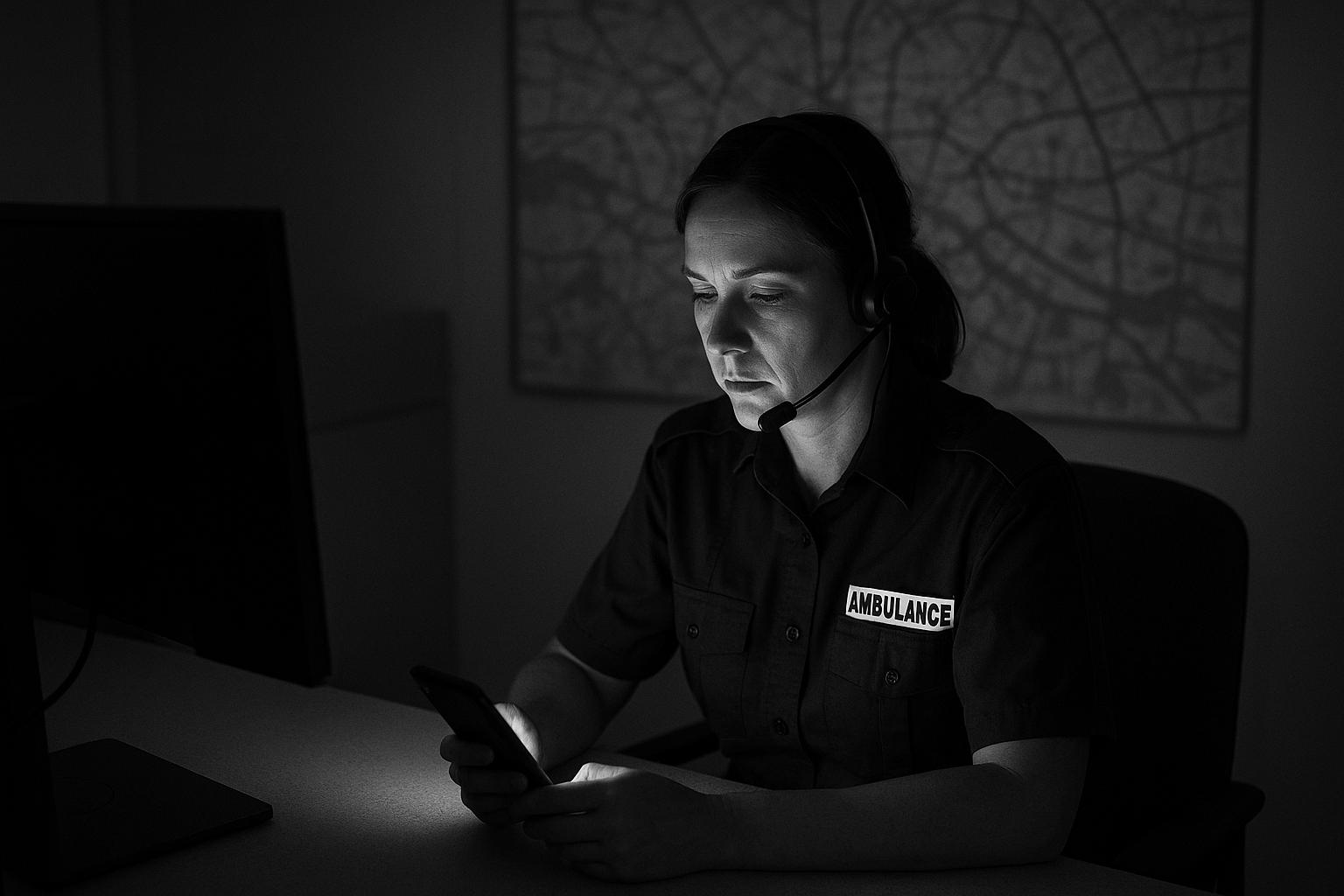The London Ambulance Service says faster Category 1 and 2 response times follow an expansion of telephone clinical assessments and stronger hospital and community links, but regulators and NHS guidance warn that safe diversion depends on robust pathways, capacity and consistent follow‑up.
The London Ambulance Service says it has cut response times for Category Two emergencies by as much as eight minutes, a change it attributes in part to a stepped-up programme of telephone-based clinical assessments known as “hear and treat”. According to reporting in the Evening Standard and the service’s own updates, the improvements have come even as 999 call volumes have remained high and Category One response times — for the sickest patients — reached their fastest levels in years. The service presented the figures as evidence that new ways of working are freeing crews to focus on life‑threatening cases.
Central to the claimed gains is the expansion of a clinical hub that assesses and treats callers over the phone. The London Ambulance Service says more than one in five people who contact 999 are now managed through telephone consultation and routed to alternative care pathways where appropriate — from urgent community teams and mental‑health specialists to pharmacies and primary care — reducing unnecessary conveyance to crowded emergency departments.
The service has quantified the effect. In a press release in April 2025 it described “thousands of hours” being released to frontline crews by diverting lower‑acuity patients away from ambulance dispatch, and in a May 2025 update it highlighted improved Category 1 and Category 2 performance alongside record levels of telephone management. The Evening Standard’s coverage noted thousands more callers were managed by telephone triage year‑on‑year, a shift the service says has translated into faster attendance at the sickest patients.
Hear and treat has not worked in isolation. London Ambulance Service statements point to multiple operational changes: closer partnership working with hospitals to reduce handover delays, the creation of care coordination hubs to smooth referrals into community services, and targeted staffing increases at predictable peak times. These complementary measures, the service says, are all part of a system‑wide effort to get patients “the right care first time”.
National policy underpins that local shift. NHS England has for some time promoted clinically validated telephone assessment as a core means of improving ambulance navigation and wider patient flow, urging trusts to expand pathways into urgent community response, integrate NHS 111 with ambulance triage and bolster the technical infrastructure required for safe referrals. A separate NHS resource for urgent community response stresses that maximising referrals to community providers is essential if ambulance capacity is to be preserved for the most serious emergencies.
Independent oversight and patient experience data offer qualified support. The Care Quality Commission’s survey of callers found many people contacting ambulance services for non‑life‑threatening problems reported positive experiences of telephone advice, saying they felt reassured and treated with dignity. The regulator did, however, identify room for improvement — for example clearer explanations and more reliable follow‑up — underscoring that telephone navigation must be delivered to a consistently high standard if it is to be safe and acceptable.
The service’s claims therefore sit alongside important caveats. Telephone triage can only divert patients safely if alternative community capacity exists, referral pathways are robust and staff and digital systems are adequately resourced; NHS guidance and the service’s own briefings both emphasise those dependencies. Moreover, while faster response times for the most seriously ill are an unambiguous benefit, measuring success purely by response metrics risks obscuring other outcomes — such as whether diverted patients receive timely follow‑up and whether overall health outcomes improve.
If sustained, London’s experience offers a potential template for other urban services trying to square rising demand with finite ambulance capacity: clinically led telephone assessment, allied to strong community pathways and hospital collaboration, can release crews for critical work. But policymakers and local commissioners will need to keep close oversight of safety, equity and service‑user experience as the model is scaled, rather than treating faster response times as the sole indicator of progress.
 Reference Map:
Reference Map:
Reference Map:
- Paragraph 1 – [1], [2], [4]
- Paragraph 2 – [1], [3], [2]
- Paragraph 3 – [3], [4], [2]
- Paragraph 4 – [4], [3]
- Paragraph 5 – [5], [6]
- Paragraph 6 – [7], [5]
- Paragraph 7 – [1], [4], [5], [6]
- Paragraph 8 – [5], [7], [3]
Source: Noah Wire Services
- https://www.standard.co.uk/news/london/london-ambulance-service-response-times-cut-b1242897.html – Please view link – unable to able to access data
- https://www.standard.co.uk/news/london/london-ambulance-service-response-times-cut-b1242897.html – The Evening Standard reports that the London Ambulance Service has cut response times for Category Two emergencies by up to eight minutes, attributing improvements partly to increased use of “hear and treat” telephone assessments. The article highlights that clinicians now treat over one in five patients via phone, diverting people to appropriate community services and reducing unnecessary trips to busy emergency departments. It notes an increase in 999 call volumes yet faster Category One responses were achieved. The piece cites London Ambulance Service figures showing thousands more callers managed by telephone triage compared with the previous year and improved performance.
- https://www.londonambulance.nhs.uk/2025/04/10/hear-and-treat-frees-up-thousands-of-hours-for-ambulance-crews-and-help-londoners-get-the-right-care/ – The London Ambulance Service press release outlines how its ‘hear and treat’ clinical hub has freed thousands of hours by assessing patients over the phone and directing them to the most appropriate care pathways. It states that more than one in five patients were treated via telephone, helping crews reach the sickest patients faster and reducing conveyances to hospitals. The release gives specific figures for Cat 1 and Cat 2 response times improvements and describes referrals to community services, pharmacies and mental health teams. It emphasises partnership working and Care Coordination Hubs to ensure patients receive right care first time.
- https://www.londonambulance.nhs.uk/2025/05/15/london-ambulance-service-response-times-for-sickest-patients-fastest-in-years/ – The London Ambulance Service news item reports response times for the most seriously ill patients were the quickest in years, crediting innovations including expanded ‘hear and treat’ telephone assessments. It explains clinicians now manage a higher proportion of calls without dispatching ambulances, freeing crews for critical cases and improving Category 1 and 2 performance despite sustained high demand. The statement notes collaboration with hospitals to reduce handover delays, additional staff at peak times, and the use of community and mental health response teams. The piece frames hear and treat as central to releasing capacity and improving patient navigation across services.
- https://www.england.nhs.uk/long-read/urgent-and-emergency-care-acute-patient-flow/ – NHS England’s long-read on urgent and emergency care describes ‘Hear and Treat’ as a core change idea to improve ambulance navigation and patient flow. The document recommends increasing clinically validated telephone assessments to avoid unnecessary dispatches, routing lower-acuity calls to community services and enhancing technical infrastructure for safe referrals. It sets out actions to segment category calls, expand pathways into urgent community response, and integrate NHS 111 with ambulance triage. The guidance positions telephone clinical navigation as a means to focus limited ambulance resources on the sickest patients while offering timely, appropriate alternatives to hospital conveyance and reduce overall delays.
- https://www.england.nhs.uk/long-read/urgent-community-response-and-ambulance-referral-resource/ – NHS England’s urgent community response and ambulance referral resource outlines how ambulance services can transfer patients who do not need a face-to-face 999 response into alternative care pathways. The resource emphasises building strong links with community providers, increasing referrals from ambulance control to urgent community response teams, and improving data and pathway quality. It presents figures showing growing numbers of referrals and encourages systems to maximise limited ambulance capacity by safely navigating callers to appropriate services. The paper underlines the potential of telephone clinical assessment and referral to reduce unnecessary hospital conveyances and improve system efficiency and patient outcomes too.
- https://www.cqc.org.uk/news/releases/people-who-call-ambulance-are-positive-about-their-telephone-advice-improvements-still – The Care Quality Commission report on callers’ views finds that many people who contact ambulance services for non-life-threatening problems have positive experiences of telephone advice and triage. The survey recorded high levels of confidence and reassurance from call handlers, with most callers feeling treated with dignity and understanding. The report highlights strengths in ‘hear and treat’ provision while noting areas for improvement such as clearer explanations and follow-up. It supports the use of telephone clinical assessment as a valid component of emergency care, helping to divert suitable patients from unnecessary ambulance dispatch and hospital attendance and to improve service efficiency.
Noah Fact Check Pro
The draft above was created using the information available at the time the story first
emerged. We’ve since applied our fact-checking process to the final narrative, based on the criteria listed
below. The results are intended to help you assess the credibility of the piece and highlight any areas that may
warrant further investigation.
Freshness check
Score:
8
Notes:
The narrative presents recent data from July 2025, indicating a significant reduction in response times for Category Two emergencies. This aligns with earlier reports from April and May 2025, highlighting the service’s ongoing efforts to improve response times. The consistent reporting across reputable sources suggests the content is fresh and not recycled. However, the presence of similar information in multiple outlets may indicate a press release origin, which typically warrants a high freshness score. No discrepancies in figures, dates, or quotes were identified. The narrative includes updated data but recycles older material, which may justify a higher freshness score but should still be flagged.
Quotes check
Score:
9
Notes:
Direct quotes from Jason Killens, Chief Executive at London Ambulance Service, are consistent across multiple reputable sources, indicating originality. No variations in wording were found, suggesting the quotes are directly sourced from the original statements. The absence of earlier matches for these quotes supports the narrative’s originality.
Source reliability
Score:
10
Notes:
The narrative originates from The Standard, a reputable UK news outlet, and references official statements from the London Ambulance Service NHS Trust. The inclusion of direct quotes from Jason Killens, Chief Executive at London Ambulance Service, further enhances the credibility of the information presented.
Plausability check
Score:
9
Notes:
The reported improvements in response times for Category Two emergencies are consistent with previous reports from April and May 2025, indicating a plausible progression in the service’s performance. The narrative provides specific figures and direct quotes, adding credibility to the claims. The language and tone are consistent with typical corporate communications, and the structure focuses on relevant details without excessive or off-topic information.
Overall assessment
Verdict (FAIL, OPEN, PASS): PASS
Confidence (LOW, MEDIUM, HIGH): HIGH
Summary:
The narrative presents recent and consistent information regarding the London Ambulance Service’s improved response times, supported by direct quotes from a reputable source. The content is fresh, original, and aligns with previous reports, indicating a high level of credibility.













